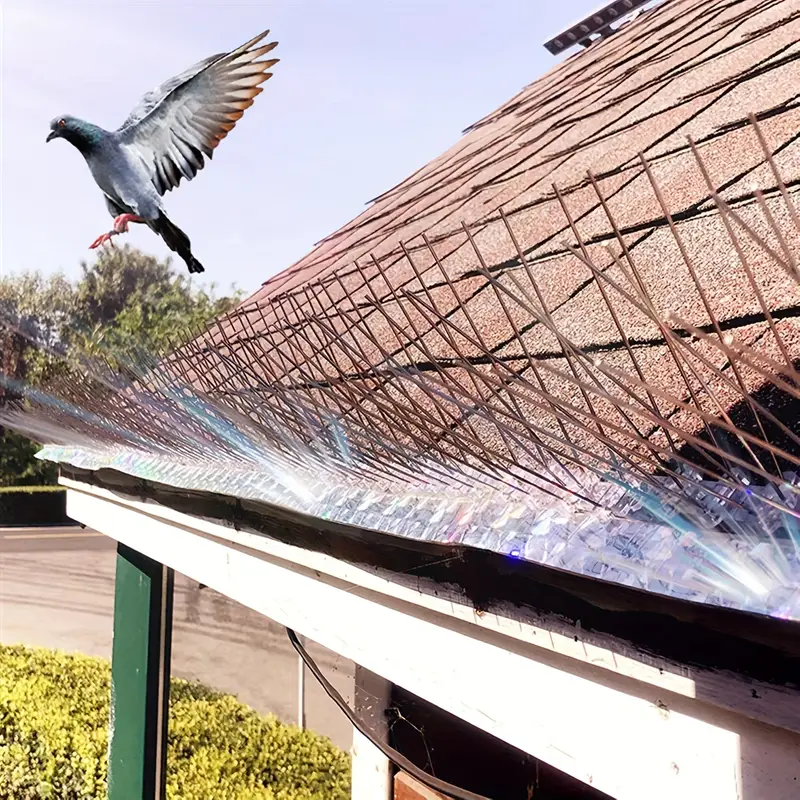Bird spikes are one of the most widely used and humane solutions for preventing birds from perching or roosting on rooftops. While birds are often welcome sights in gardens and parks, they can become a problem when they gather on rooftops in large numbers. Their droppings, nesting materials, and noise can cause significant damage and inconvenience. Bird spikes provide a practical way to deter birds without harming them, protecting both the building and the birds themselves.
Understanding the Purpose of Bird Spikes
Bird spikes are mostly used to physically block certain areas, making it difficult or impossible for birds to settle there. They discourage birds from gaining a firm grip when mounted on a roof. Instead of hurting the birds, these spikes change the landing area, which makes the birds search for other places to roost. They are therefore an eco-friendly and humane way to control birds.
Bird spikes are frequently employed to keep out birds including starlings, crows, seagulls, and pigeons. Rooftops are frequently selected by these birds as secure locations for resting, nesting, or observing their surroundings. Their presence over time can result in unattractive messes that are expensive to clean, blocked gutters, and structural damage.
Types of Bird Spikes Available
Bird spikes for roofs come in a variety of materials and designs to suit different needs. Stainless steel spikes are highly durable and weather-resistant, making them ideal for long-term outdoor use. They are also less visible from a distance, blending better with most building exteriors. Plastic bird spikes, often made from UV-resistant polycarbonate, are lightweight and available in multiple colors to match the building’s appearance.
Because the spikes' breadth and length vary, property owners can select the ideal size for various roof ledges or edges. While some are narrow and unobtrusive for little perching places, others are made with extra-wide coverage for larger birds. The size of the bird spikes in dubai problem and the building owner's aesthetic choices will determine which type is best.
Benefits of Installing Bird Spikes on Roofs
One of the main advantages of bird spikes is their long lifespan. Once installed, they require very little maintenance, and their effectiveness does not diminish over time. This makes them a cost-effective investment compared to repeated cleaning or repairs caused by bird damage.
Another significant benefit is hygiene. Bird droppings can be acidic and corrosive, damaging roof materials and creating health hazards. The droppings can also stain surfaces, making buildings look neglected. By keeping birds off the roof, spikes help maintain a clean, professional appearance for both residential and commercial properties.
Additionally, bird spikes are a humane solution. Unlike harmful traps or poisons, they do not cause injury. They simply remove the comfort factor for birds, encouraging them to relocate naturally to safer, more suitable habitats.
Installation Process of Bird Spikes
Installing bird spikes on a roof is a straightforward process but requires proper preparation to ensure effectiveness. First, the area should be thoroughly cleaned to remove any dirt, droppings, or nesting materials. This prevents bacteria from spreading during installation and ensures that adhesives or fasteners stick properly.
Spikes can be installed using adhesive glue for non-intrusive attachment or with screws and nails for more permanent solutions. They should be positioned in a continuous line along the roof edge or ledge, with no gaps where birds could squeeze through. Corners, chimneys, and other flat surfaces that attract birds should also be considered for spike placement.
While many homeowners choose to install spikes themselves, professional installation ensures that the spikes are placed optimally and securely, especially for large or complex roofs.
Maintenance and Longevity
Once installed, bird spikes require very little upkeep. Occasionally, they may need cleaning if leaves, debris, or other materials become trapped between the spikes. For stainless steel models, a quick rinse can restore their appearance, while plastic spikes may benefit from a gentle wipe to remove dirt.
High-quality spikes can last for years without losing effectiveness, especially stainless steel versions, which can endure harsh weather conditions without rusting. Periodic checks are recommended to ensure that no sections have become loose or damaged over time.
Environmental and Ethical Considerations
Property owners that care about the environment favor bird spikes because of their humanitarian character. Spikes help maintain a balance between the needs of people and the preservation of nature by keeping birds from roosting instead of hurting them. Birds will just move to better places to reside, usually close to trees or open areas where they won't interfere with structures.
It's also crucial to remember that some bird species are legally protected in many places. A morally and legally acceptable method of discouraging birds without violating wildlife protection laws is to install bird spikes.
Conclusion
Bird spikes for roofs are a proven, cost-effective, and humane solution for keeping unwanted birds away from buildings. They protect property from structural damage, prevent health risks associated with bird droppings, and maintain a building’s clean appearance. With a variety of materials and designs available, they can be tailored to suit different building styles and bird control needs.
